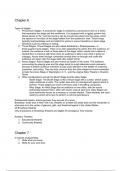Chapter 6
Types of stages:
1. Proscenium Stages- A proscenium stage is marked by a proscenium arch or a frame
that separates the stage and the auditorium. It is equipped with a rigging system that
allows pieces to "fly," and the scenery can be moved into place from the wings, which
are spaces on the sides of the stage hidden from the audience's view. These wings
typically lead backstage and are helpful for actors in scene transitions or basic stage
directions such as entering or exiting.
2. Thrust Stages- Thrust Stages are also called Elizabethan, Shakespearean, or
three-quarter-round stages. There is no arch separating the actors from the audience, so
instead, the audience is sat on three sides of the stage, which usually has a raked or
slanted floor to improve sight lines (how an audience is able to see what is going on
onstage). Actors enter through vomitories (tunnels that run through and under the
audience and open near the stage itself–also called Voms).
3. Arena Stages- Arena Stages are also known as theatre in the round. The audience
surrounding the playing area and the stage tends to avoid elaborate scenic elements
because it prefers audience members to pay close attention to the details of costumes,
properties, and acting. They are less common than the other stages but some examples
include the Arena Stage in Washington, D. C., and the original Alley Theatre in Houston,
Texas.
4. Other configurations include the Booth Stage and the Alley Stage.
- Booth Stage: The Booth Stage is like a thrust stage with a curtain, where actors
make entrances or exits. The curtain also acts as a background against which to
perform. These stages are most commonly used in travelling companies.
- Alley Stage: An Alley Stage has an audience on two sides, with the actors
performing between them, often with scenic units at each end. Alley Stages are
more commonly known as a traverse or corridor theatre. These theatres are used
mainly by actors who have to perform in school gymnasiums.
Professional theatre- actors get paid, they are part of a union
Broadway- small area in New York City, theatres w/ at least 500 seats each are the remainder of
what was once the center of glamour, glitz, and theatrical legend in the United States.
40 Broadway theatres
Only productions in Broadway theatres are eligible for prestigious Tony Awards.
Amateur Theatres
1. Educational theatres
2. Community theatres
Chapter 7
5 maxims of playwriting:
1. Write what you know.
2. Write for your own time.
, 3. Write action, not speeches.
4. Write for actors, not readers.
5. Be passionate, not timid; truthful, not nice.
Writing the play
1. The genesis- inspiring observation or accident or thought
2. After the genesis- if genesis is story then next step is characters, if genesis is person
or the playwright’s self (character) then next step may be language (burst of statements
of character) or action, if genesis is an idea then next step is probably character but
may be story-a chain of incidents that embody and illustrate the idea, if genesis is
language the next step is the character- who says it and why, if genesis is a situation
then next step is dialogue but has to be an action: what do they do not what do they
say, if genesis is history and a real person then the next step is probably story-trying to
make a fictional beginning, middle, and end of a real life.
3. The development- situation: rough ideas of setting, social level, relationships and
important aspects of the play’s world: politics, religion, and conditions of threat; tone:
coic or serious or satirical or mixed; plot: the ordering of incidents as they relate to
character, action, and idea; form: whether the play is to be long or short, in quick scenes
or long acts, or in a single piece or three or five.
4. Dialogue
5. Finishing a draft
6. Practicalities
7. Audiences- establish the “laws” of drama.
What is good playwriting?
Good playwriting produces good theatre.
Chapter 8
Accomplished and experienced actors respect the etiquette of their profession, an etiquette that
includes being:
1. Prompt- they arrive for rehearsals on time, alert, and ready to work.
2. Prepared- they bring to rehearsals whatever homework on the play has been requested
3. Constructive, not destrcutive- they do not make comments about other actors, do not
break out of character while another actor is working, and do not indicate in any way that
another actor’s experiment with a character is dumb.
4. Respectful- They talk to the director about problems not to other actors, the costume
designer, or the playwright.
5. Aware- They know the theatre’s past and its literature.
An actor’s training almost always involves at least these three characteristics:
1. Analyzing the script
2. Training the actors instrument
3. Training the actors imagination
Body language and nonverbal communication:
1. Rhythmic movement: including ballroom dancing, simple modern dance, disco dancing,
and the like to help the actor move to an external rhythm.




